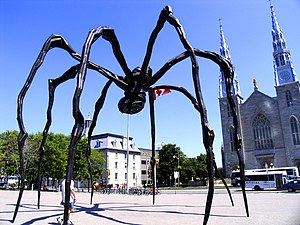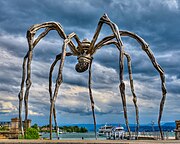Maman (sculpture)
| Maman | |
|---|---|
 Maman at the National Gallery of Canada, Ottawa | |
| Artist | Louise Bourgeois |
| Year | 1999 |
| Type | Sculpture |
| Medium | Stainless steel, bronze, marble |
| Dimensions | 9271 x 8915 x 10236 mm |
Maman (1999) is a bronze, stainless steel, and marble sculpture by the artist Louise Bourgeois. The sculpture, which depicts a spider, is among the world's largest, measuring over 30 ft high and over 33 ft wide (927 x 891 x 1024 cm).[1] It includes a sac containing 32 marble eggs and its abdomen and thorax are made of ribbed bronze.
The title is the familiar French word for Mother (akin to Mummy). The sculpture was created in 1999 by Bourgeois as a part of her inaugural commission of The Unilever Series (2000), in the Turbine Hall at London's Tate Modern.[1] This original was created in steel, with an edition of six subsequent castings in bronze.[2]
Bourgeois chose the Modern Art Foundry to cast the sculpture because of its reputation and work.[3]
Philosophy and meaning[]


The sculpture picks up the theme of the arachnid that Bourgeois had first contemplated in a small ink and charcoal drawing in 1947, continuing with her 1996 sculpture Spider.[4] It alludes to the strength of Bourgeois' mother, with metaphors of spinning, weaving, nurture and protection.[5] Her mother, Josephine, was a woman who repaired tapestries in her father's textile restoration workshop in Paris.[4] When Bourgeois was twenty-one, she lost her mother to an unknown illness. A few days after her mother's passing, in front of her father (who did not seem to take his daughter's despair seriously), Louise threw herself into the Bièvre River; he swam to her rescue.[6]
The Spider is an ode to my mother. She was my best friend. Like a spider, my mother was a weaver. My family was in the business of tapestry restoration, and my mother was in charge of the workshop. Like spiders, my mother was very clever. Spiders are friendly presences that eat mosquitoes. We know that mosquitoes spread diseases and are therefore unwanted. So, spiders are helpful and protective, just like my mother.
— Louise Bourgeois[5]
Permanent locations[]
Some of these editions in permanent collections often tour on exhibit:
- Tate Modern, UK – The permanent acquisition of this sculpture in 2008 is considered one of the Tate Modern's historical moments. Maman was first exhibited in the turbine hall and later displayed outside the gallery in 2000. It was received with mixed reactions of amazement and amusement. The sculpture owned by the Tate Modern is the only one made from stainless steel.[5]
- National Gallery of Canada, Ottawa, Canada – The National Gallery of Canada acquired the sculpture in 2005 for 3.2 million dollars. At that time, the price was deemed excessive by some critics, as it took around a third of the annual budget of the gallery.[7]
- Guggenheim Museum Bilbao, Spain[8]
- Mori Art Museum, Tokyo, Japan[9] – On display at the base of Mori Tower, outside the museum.[10]
- Leeum, Samsung Museum of Art, South Korea[11]
- Crystal Bridges Museum of American Art, Bentonville, Arkansas, USA[12]
- Qatar National Convention Center, Doha, Qatar[13]
Temporary locations[]
Tours and featured exhibitions of Maman include:
- 2001: Rockefeller Center Plaza, New York[1]
- 2001: City Hall, The Hague, The Netherlands[citation needed]
- 2002: State Hermitage Museum, St. Petersburg, Russia[1]
- 2003: Nytorv, Copenhagen, Denmark[citation needed]
- 2006: Mariakerke, Ostend, Belgium[14]
- 2007: Wanås Castle, Sweden
- 2008: Jardin des Tuileries, Paris, France[15]
- 2008: Centre Georges Pompidou, Paris, France[16]
- 27 March 2007 – 2 March 2008: Institute of Contemporary Art, Boston, Massachusetts[citation needed]
- 18 October 2008 – 25 January 2009: Museo di Capodimonte, Naples, Italy[citation needed]
- 2011: Fundacion Proa, Buenos Aires, Argentina[16]
- Museu de Arte Moderna (MAM), São Paulo, Brasil, 2011
- Bundesplatz, Bern, Switzerland, 24 May 2011 – 7 June 2011[15]
- Bürkliplatz, Zürich, Switzerland, 10 June 2011 – 2 August 2011[15]
- Place Neuve, Geneva, Switzerland, 3 August 2011 – 28 August 2011
- Fondation Beyeler, Riehen/Basel, Switzerland, 3 September 2011 – 8 January 2012[15]
- Kunsthalle, Hamburg, Germany, 23 January 2012 – 17 June 2012
- Qatar National Convention Center, Qatar – The Maman sculpture; exhibited from 20 January – 1 June 2012, at the Qatar National Convention Centre as the centerpiece of the Conscious and Unconscious exhibition; the first solo exhibit of Bourgeois' work to be displayed in the Middle East.[17] The exhibit was organised by the Qatar Museums Authority.[18]
- Roppongi Hills, Tokyo, Japan, 2012 – 2013
- Qatar National Convention Centre, , Qatar, February 2014
- Palacio de Bellas Artes, Mexico City, Mexico, 15 November 2013 – 2 March 2014
- Moderna Museet, Stockholm, Sweden, January 2015 – 17 May 2015
- Museum Voorlinden, The Hague, the Netherlands, till 17 may 2020
See also[]
- Cultural depictions of spiders
- List of artworks by Louise Bourgeois
- Spider (Bourgeois)
- Featured in Denis Villeneuve's 2013 film, Enemy.
Gallery[]

Exhibited at the Moderna Museet, Stockholm, Sweden.
View from the National Gallery, Ottawa, Canada

At the Guggenheim Museum, Bilbao, Spain

The sculpture in La Boca, Buenos Aires, Argentina

At Lake Zürich, Zürich, Switzerland

At Hamburger Kunsthalle, Hamburg, Germany

At Palacio de Bellas Artes, Mexico City, Mexico
References[]
- ^ Jump up to: a b c d "Maman". Collections. The National Gallery of Canada. Retrieved 18 January 2014.
- ^ Manchester, Elizabeth (December 2009). "Summary". Louise Bourgeois : Maman 1999. Tate, London. Retrieved 18 January 2014.
- ^ Anderson, Nicole Gates (6 September 2012). "Where Bronze Transforms Into Fine Art". NEIGHBORHOOD JOINT. New York Times.
- ^ Jump up to: a b Louise Bourgeois, Spider (1996) Christie's Post-War Contemporary Evening Sale, 8 November 2011, New York.
- ^ Jump up to: a b c "Tate acquires Louise Bourgeois's giant spider, Maman". Tate. Retrieved 11 January 2008.
- ^ Louise Bourgeois, 5 March – 2 June 2008 Centre Pompidou, Paris.
- ^ Home To Maman: getting to know the mother of all sculptures in the Ottawa landscape
- ^ Beaven, Kirstie. "Louise Bourgeois: Maman Work of the Week, 1 June 2010". Tate, London. Archived from the original on 3 February 2014. Retrieved 18 January 2014.
- ^ Martin, Amy. "Louise Bourgeois and Her Most Famous Piece: Maman". Art History. Answers Corporation. Archived from the original on 19 February 2014. Retrieved 22 January 2014.
- ^ Richmond, Simon; Dodd, Jan (2011). "Roppongi Hills". The Rough Guide to Japan (5th ed.). London: Rough Guides. p. 223. ISBN 978-1405389266.
- ^ "Maman". Collection. Leeum. Retrieved 18 January 2014.
- ^ "Crystal Bridges Museum of American Art announces the acquisition of four key artworks by acclaimed American artist Louise Bourgeois | Crystal Bridges Museum of American Art". crystalbridges.org. Retrieved 21 January 2017.
- ^ "Maman by Louise Bourgeois". Qatar Museums. Retrieved 4 March 2017.
- ^ [1]. 14 June 2018.
- ^ Jump up to: a b c d "Louise Bourgeois's Sculpture "Maman" on Tour Prior to Major Exhibition at Fondation Beyeler". artdaily.org. Retrieved 18 January 2014.
- ^ Jump up to: a b de Arteaga, Alicia (13 February 2011). "Una araña gigante en La Boca". La Nación. Retrieved 18 February 2011.
- ^ Louise Bourgeois Solo Show to Open in Qatar
- ^ Louise Bourgeois: Conscious and Unconscious Archived 2 February 2014 at the Wayback Machine
External links[]
| Wikimedia Commons has media related to Maman by Louise Bourgeois. |
- Maman spider sculpture debuts in Ottawa – CBC Archives (Broadcast: 10 May 2005)
- Video : "They climb it" – Vimeo
- Louise Bourgeois – Maman – National Gallery of Canada (videos)
- Works by Louise Bourgeois
- 1999 sculptures
- Spiders in art
- Bronze sculptures in Canada
- Bronze sculptures in Japan
- Bronze sculptures in the United States
- Stainless steel sculptures
- Steel sculptures in the United Kingdom
- Outdoor sculptures in Arkansas
- Outdoor sculptures in Tokyo
- Sculptures of the Tate galleries
- Collection of the Crystal Bridges Museum of American Art
- Colossal statues in the United States
- Colossal statues in the United Kingdom






